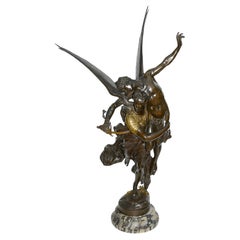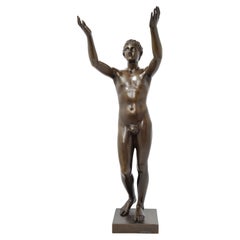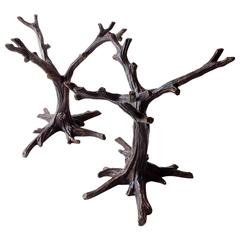J.A. Mercie Furniture
to
1
1
1
1
1
1
1
1
1
1
1
1
1
11,549
3,905
2,408
2,232
Creator: J.A. Mercie
19th Century Gloria Victis bronze statue, By Barbedienne.
By F. Barbedienne Foundry, J.A. Mercie 1
Located in Brighton, Sussex
A very impressive 19th Century patinated bronze statue of 'Gloria Victis' with gilded highlights. Raised on a marble plinth.
Signed; A MERCIE
Stamped; F. BARBEDIENNE
Gloria Victis wa...
Category
19th Century French Antique J.A. Mercie Furniture
Materials
Marble, Bronze
Related Items
19th Century Bronze Statue of Bartolomeo Colleoni
Located in Esbeek, NL
This patinated bronze statue is after the original Renaissance sculpture which was executed by Andrea del Verrocchio in 1480–1488, in Italy. Exac...
Category
19th Century Italian Antique J.A. Mercie Furniture
Materials
Bronze
19th Century Bronze Figure of the Berlin Adorante by Barbedienne Foundry
By F. Barbedienne Foundry
Located in 263-0031, JP
A 19th-century patinated bronze figure of the Berlin Adorante, or Praying Boy. The piece is a reduction of the Hellenistic-era original, currently in t...
Category
19th Century French Neoclassical Antique J.A. Mercie Furniture
Materials
Bronze
$2,208 Sale Price
20% Off
H 22.45 in W 8.47 in D 8.27 in
Exceptional 19th Century Bronze Entitled ““Quand Meme” by Mercié and Barbedienne
By Ferdinand Barbedienne, Antonin Mercie
Located in Long Island City, NY
A Large and Exceptional Late 19th Century Patinated Bronze Figural Group Entitled “Quand Meme” by Mercié and Barbedienne on Pedestal
Marius-Jean-Antonin Me...
Category
Late 19th Century French Belle Époque Antique J.A. Mercie Furniture
Materials
Bronze
$65,000 / set
H 50 in W 27 in D 22 in
19th Century French Bronze Tazza Dish by Ferdinand Barbedienne
By F. Barbedienne Foundry
Located in Casteren, Noord-Brabant
A Roman-classical style decorative bowl, cast in bronze, brown patinated finish. This antique coupe is signed by Ferdinand Barbedienne (France, 1810-1892). In the center a depiction ...
Category
Late 19th Century French Classical Roman Antique J.A. Mercie Furniture
Materials
Bronze
19th Century Bronze Tazza by Barbedienne
By F. Barbedienne Foundry, Ferdinand Levillain
Located in Palm Springs, CA
A good 19th century Italian bronze neo-greque footed Tazza with scrolled handles and arge, round centrepiece, in the centre with a round relief medallion with an antique classical sc...
Category
19th Century French Neoclassical Revival Antique J.A. Mercie Furniture
Materials
Bronze
French 19th C Gilt and Patinated Bronze Group of Gloria Victis, by A. Mercie
By F. Barbedienne Foundry, Antonin Mercie
Located in New York, NY
An Incredible and Large Gilt and Patinated Bronze Group of Gloria Victis, a Winged Figure of Victory with a Fallen Warrior. This incredible bronze piece was cast after a model by Maarius-Jean-Antonin Mercié, This model is signed 'F. BARBEDIENNE FONDEUR PARIS' demonstrating that it was cast by Ferdinand Barbedienne's foundry, the best bronzier of the 19th century. The base is further signed 'A. Mercie' and stamped 'Réduction Mécanique' with an inscription of '659'. The figure is mounted on a Belgian noir marble base with various stepped edges. Gloria Victis is one the most well-known and important bronze casts of the 19th Century. The quality of this particular model is absolutely incredible and all the marking indicate that this particular piece is one of the finest produced by the Foundry.
A student of Jouffroy and de Falguière at the Ecole des Beaux-Arts, Marius-Jean-Antonin Mercié (1845-1916) won the Grand Prix de Rome at 23 years old with his work Thésée vainqueur du Minotaure. In 1872, he sent the plaster model of his work David vainqueur to the Salon, for which he won the first class medal. At the same time, he received La croix de la Légion d'honneur at the Villa Medici. His return to Paris, in 1874, issued in a long and brilliant career with numerous commissions, notably the monuments for Louis-Philippe and Queen Marie-Amélie for the Royal Chapel at Dreux (1886).
By the age of 30 Mercié was already very well-known and his Gloria Victis received resounding success when it was exhibited at the Salon, in 1874 (in plaster) and in 1875 (in bronze). This work exalted the heroism and the patriotic sentiments aroused by the disasters of 1870. His predilection for patriotic subjects is shown in many of his works such as Quand même...
Category
19th Century French Louis XVI Antique J.A. Mercie Furniture
Materials
Belgian Black Marble, Bronze
$29,726
H 31.5 in W 9.5 in D 8 in
19th Century Silvered Bronze Athénienne Jardinière by Ferdinand Barbedienne
By Ferdinand Barbedienne
Located in Oxfordshire, United Kingdom
A French silvered-bronze athénienne by Ferdinand Barbedienne, Paris, last quarter 19th century with a revolving liner, the frieze applied with bucrania suspending ribbon-tied berried laurel swags above a border of bellflowers on a stippled ground above three seated female sphinxes issuing stylised foliage and scrolls on lion monopodia cast with the mask of Hercules, scrolling foliage and anthemions joined by stretchers, raised on a concave-sided triform marble base on a further thin silvered-bronze base, inscribed to the tripod base 'F. BARBEDIENNE'
Measures: 103.3cm. high, 41.5cm. diameter; 3ft. 4 3/8 in, 1ft. 4 1/4.
This impressive athénienne is a key reminder of the longevity of a particular model and design’s success from Antiquity through to the 19th century and up until this day. Typically known as the ‘Trépied du Temple d’Isis’, this athénienne is designed after the Roman antique originally found at Pompeii and now at the Museo Archeologico Nazionale, Naples (fig.1). From being for example an inspiration for the baptismal font of Napoléon’s son in 1811, this model was the inspiration to many highly skilled makers throughout the 19thcentury such as the Manfredini brothers from Milan and of course the Parisian well-established bronze founder Ferdinand Barbedienne who executed the present example.
The Temple of Isis was a Roman temple dedicated to the Egyptian goddess Isis and was among one of the first discoveries during the excavation of Pompeii in 1764. Certainly considered as one of the most elegant examples of antique tripods, the existence of this model was then popularized to the rest of Europe via prints, one of the first being by Giovanni Battista Piranesi in 1779. This type of tripod was also popularised by an engraving in C. Percier and P. Fontaine’s, Receuil de Décorations Intérieures of 1801. Interestingly, there is also a watercolour now in the Musée Carnavalet, Paris, showing this type of tripod displayed at the 1801 Exposition des Produits de L’Industrie in the Louvre.
The passion for Greek and Roman Art in the 19th century.
The discovery of Pompeii and Herculaneum around the middle of the 18th century gave rise to a new passion for Antiquity and the excavated masterpieces renewed the repertoire of fine and decorative arts and served as models for Neoclassicism. Members of the aristocracy as well as connoisseurs, particularly in England, completed their education by undertaking a ‘Grand Tour’ of Italy and often fell victim to the recently unearthed Greek and Roman artefacts...
Category
19th Century French Grand Tour Antique J.A. Mercie Furniture
Materials
Marble, Silver Plate, Bronze
$66,419
H 40.56 in Dm 16.34 in
19th Century Demosthenes Bronze Sculpture by Barbedienne Foundry
By F. Barbedienne Foundry
Located in 263-0031, JP
A bronze figure representing Demosthenes (384-322 BC), a Greek statesman and orator. The sculpture is based on a Roman copy of an original Greek statue. The chocolate-brown patina of...
Category
19th Century French Neoclassical Antique J.A. Mercie Furniture
Materials
Bronze
$5,520
H 15.95 in W 5.91 in D 4.14 in
19th Century Bronze Statue of a Nymph by A. Carrier
By Albert-Ernest Carrier-Belleuse
Located in Vancouver, British Columbia
A very fine cast and chased bronze showing a beautiful standing nude nymph, parting and emerging from between tall bull rushes at the edge of a stream. At her feet is a water jug. Th...
Category
Late 19th Century French Napoleon III Antique J.A. Mercie Furniture
Materials
Bronze
19th Century Bronze Statue of Caesar
Located in New Orleans, LA
Beautifully Chased Bronze Figure of Caesar.
Category
19th Century French Antique J.A. Mercie Furniture
Materials
Bronze
Sculpture in Patinated Bronze by Ferdinand Barbedienne, 19th Century.
By Ferdinand Barbedienne
Located in Saint-Ouen, FR
Sculpture in patinated bronze by Ferdinand Barbedienne, 19th century, Napoleon III period.
A 19th century patinated bronze sculpture, Napoleon I...
Category
19th Century French Napoleon III Antique J.A. Mercie Furniture
Materials
Bronze
$9,696
H 19.1 in W 11.42 in D 10.24 in
Henri Michel Chapu "La Jeunesse" Bronze Statue by Barbedienne H 46.5 inches
By Henri-Michel-Antoine Chapu, F. Barbedienne Foundry
Located in London, by appointment only
A very large parcel-gilt bronze figural sculpture: “La Jeunesse”
By Henri Michel Chapu (1833-1891)
Signed Chapu, F. Barbedienne Foundeur Paris, Seal Achi...
Category
Late 19th Century French Art Nouveau Antique J.A. Mercie Furniture
Materials
Bronze
$20,127
H 46.5 in W 14 in D 12.5 in
Previously Available Items
Mid-20th Century French Bronze Tree Sculpture Dining Table Base by J. A. Mercie
By J.A. Mercie 1
Located in Las Vegas, NV
French cast bronze tree sculpture dining table base signed J. A. Mercie
A stunning organic design element for the eclectic home.
Sold ind...
Category
Mid-20th Century French Aesthetic Movement J.A. Mercie Furniture
Materials
Bronze
H 30 in W 32 in D 32 in
Ja Mercie 1 furniture for sale on 1stDibs.
Ja Mercie 1 furniture are available for sale on 1stDibs.



